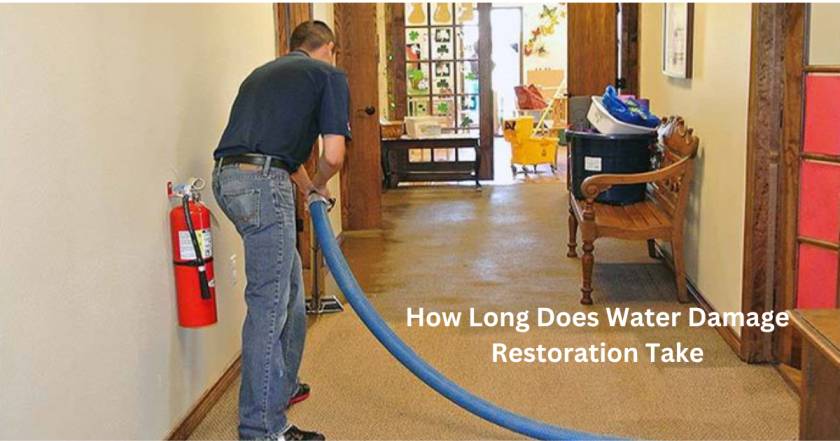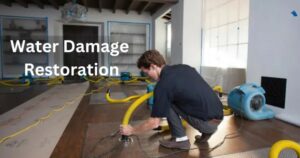Do you know How Long Does Water Damage Restoration Take? Learn the time it takes for water damage restoration & drying process. Water damage restoration typically spans from a few days to several weeks, contingent upon the extent of the damage and the size of the affected area. Swift action and professional intervention are crucial to curbing damage, guaranteeing a secure living environment, and preventing potential health hazards like mould infestation.
How Long Does Water Damage Restoration Take
Are you navigating the waters of water damage restoration? Wondering just how long it takes to turn the tide on property woes? From burst pipes to leaky roofs, water damage is no small matter. Let’s dive into the journey and find out the real deal about restoration timelines. So, grab your life vest – we’re about to explore the world of water damage restoration and its time frame.
Factors That Impact Water Damage Restoration Time
Property Size Matters
The dimensions of the property play a pivotal role in determining the restoration timeline. Larger homes or commercial structures with substantial water damage will inherently demand more time for comprehensive restoration. The square footage of the affected area directly influences how quickly things dry and the scope of repairs necessary. For instance, a compact room hit by water damage may need just a few days for restoration. At the same time, a multi-story property inundated by widespread flooding could necessitate several weeks of restoration work.
Grading the Severity
The severity of water damage varies due to factors like the source of the water, the duration of exposure, and the extent of flooding. Properties soaked in significant flooding or long-standing leaks necessitate more involved repairs and extensive mold remediation. This can elongate the restoration process. The presence of blackwater (contaminated water laden with sewage) introduces further safety concerns and demands specialized cleanup protocols, ultimately stretching the restoration timeline.
Nature of Water Contamination
The complexity of water damage restoration is further compounded by the nature of water contamination involved. There are three categories of water contamination:
Clean Water (Category 1): This water stems from pure sources such as broken pipes or rainwater. Restoration for clean water damage is more straightforward and faster as it poses fewer health risks.
Gray Water (Category 2): Gray water contains some level of contaminants, often originating from sources like washing machines or dishwashers. Restoration entailing gray water may require more time due to the need for extra cleaning and sanitization.
Black Water (Category 3): Blackwater is severely contaminated and may harbor harmful bacteria, sewage, or chemicals. Restoration work involving black water mandates stringent safety measures and specialized equipment, ultimately elongating the restoration process.
Materials in the Building
Diverse building materials react differently to water damage, influencing the drying process and the restoration schedule. Porous materials like drywall, wood, and carpet tend to retain moisture longer, necessitating more time for thorough drying and repairs. Non-porous materials such as tiles and metal generally dry more swiftly. Grasping the unique properties of each material is crucial for an effective restoration process.
Water Damage Restoration Process
Step 1: Inspection and Assessment
The initial phase of water damage restoration entails a comprehensive assessment by certified professionals to gauge the extent of the damage. Identifying potential hazards such as asbestos is paramount before embarking on any repairs. This assessment forms the bedrock for a tailored restoration plan, encompassing safety measures and equipment requisites.
Step 2: Water Extraction and Drying
State-of-the-art equipment, including industrial-grade dehumidifiers and influential fans, are harnessed to draw out water and hasten the drying process efficiently. While it generally takes about 72 hours for affected areas to dry entirely, more substantial areas impacted by water damage might necessitate a longer duration. Swift and meticulous water extraction is critical to thwarting secondary damages like mould proliferation and structural decay.
Step 3: Structural Repairs
The repair of structural elements marred by water, such as walls, flooring, and ceilings, constitutes a pivotal stage in the restoration process. The complexity of repairs hinges on the extent of the damage. Swift and precise repairs are pivotal to reinstating the property’s structural integrity and precluding further deterioration.
Step 4: Mold Remediation
Mould growth is a frequent aftermath of water damage, particularly if restoration efforts are delayed. Mould remediation is a distinct process that encompasses the safe removal and prevention of mould proliferation. In severe cases, this might necessitate additional time. Certified mould remediation experts adhere to rigorous protocols to ensure effective mould eradication and forestall its resurgence.
Step 5: Sanitization and Deodorization
Post-water extraction and repairs, comprehensive sanitization and deodorization are imperative to eliminate bacteria, odours, and potential allergens. Specialized cleaning agents and equipment are employed to reinstate the property to a secure and habitable condition.
Step 6: Content Restoration
Water damage frequently affects personal possessions, furniture, and electronic gadgets. Content restoration encompasses salvaging, cleaning, and reinstating these items whenever possible. Delicate items might warrant specialized treatments to ensure their preservation.
Step 7: Final Inspection and Quality Assurance
Once the restoration process concludes, a final inspection is carried out to ensure that all repairs and restoration work align with industry standards and regulations. This phase is pivotal in furnishing a safe and healthy environment for the property’s inhabitants.
In Conclusion
In sum, the timeline for water damage restoration hinges on myriad factors, including property size, damage severity, water contamination type, and building materials. Swift action and professional intervention are pivotal to minimizing damage, forestalling potential health hazards like mold growth, and ensuring a successful restoration journey. If you confront water damage on your property, promptly reach out to a dependable water damage restoration company to mitigate the damage and resurrect your abode or business to its pre-damaged state.
FAQ Section of How Long Does Water Damage Restoration Take
How swiftly can water wreak havoc in your residence?
Water can commence its damaging course within an hour of exposure. Within the initial 6-8 hours, water can start affecting porous materials, furniture, and structural components. Acting promptly is imperative to curtail further damage and truncate the overall restoration timeline.
Can water damage induce structural impairment?
Yes, prolonged water exposure can indeed lead to structural weakening. Over time, water erodes building materials, compromising the structural robustness of walls, floors, and ceilings. Swiftly addressing water damage is paramount to stave off subsequent structural woes and costly repairs.
How swiftly does mold sprout within damp walls?
Mold can begin burgeoning within 24 to 48 hours within damp walls. Mold spores permeate the air, and when they encounter a moisture-laden environment, they burgeon swiftly. Addressing water damage posthaste is imperative to thwart mold growth and potential health perils.
What’s the price tag for water damage restoration?
The cost of water damage restoration fluctuates based on the damage extent and the square footage of the affected region. On average, restoration expenses might span from $2,000 to $5,000. Nonetheless, the actual cost hinges on the specific restoration requisites and the damage severity.
Can I personally undertake water damage restoration?
It is unadvised to undertake water damage restoration personally. DIY restoration can pose safety hazards and might not comprehensively address the issue. Water damage restoration companies possess the requisite expertise, equipment, and protocols to ensure a thorough and secure restoration process. Enlisting professionals will guarantee efficient and effective restoration while mitigating potential health risks.
Connect With Boston Fire & Flood
If you require any form of service, don’t hesitate to reach out to us. We’re perpetually prepared to deliver top-tier service tailored to your preferences.
Boston Fire & Flood
Location: Greater Boston
Phone Number: 339-675-1388


